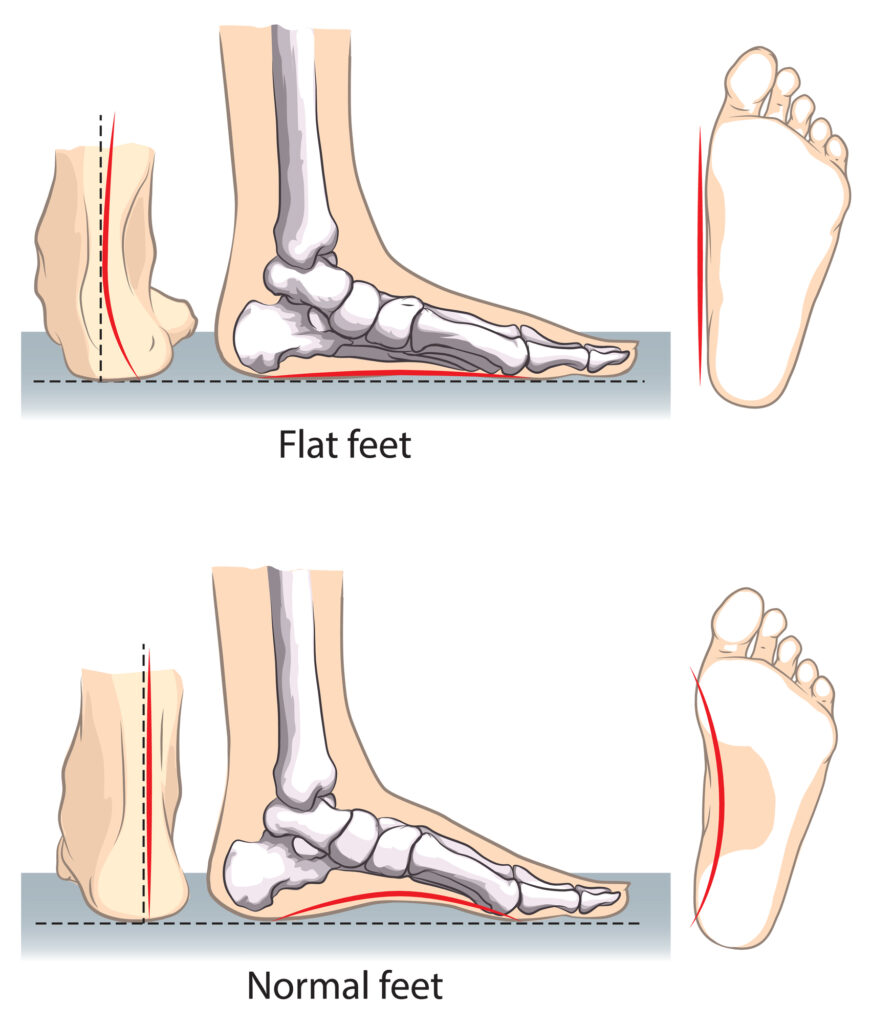Flat Feet: Symptoms, Treatments & More

Flat feet, which goes by other names like flatfoot, pronated foot, pes planus, and fallen arches, is a type of deformity with various degrees of physical impact. Flat feet are marked by no arch and the whole sole of your foot nearly touches or does touch the ground while you’re standing.
Flatfoot is a foot condition in which the arch of the foot has either partially or totally dropped or has never developed. While it is common in babies and small children, it can become a problem for them in adulthood if the arch never forms. For adults, the development of flat feet can be brought upon by injury, as a result of pregnancy due to increased elasticity, or obesity. Those who have health concerns such as rheumatoid arthritis or diabetes may also be at greater risk for developing the condition.
Flat feet in one or both of your feet can be hereditary and passed down to family members or might simply occur over time.
Symptoms of Flat Feet
The most identifiable characteristics and symptoms of flat feet are the lack of or decrease in the arches in your feet (particularly when weight-bearing) and fatigue/pain along your arches and the inner side of your feet.
Some symptoms of flat feet are:
- Arch, foot and leg fatigue
- Soft tissue inflammation
- Shin splints
- Foot, heel, and ankle pain
- Hammertoe
- Hip, knee and lower back pain
- Bunions
- Abnormal walking patterns
- Arthritis
- Rolled-in ankles
- Posterior tibial tendon dysfunction (PTTD)
- Plantar fasciitis
Some additional common signs of flatfoot include toe drift (in which the toes and front part of the foot point outward), a short Achilles tendon, and a heel that tilts outwardly while the ankle tilts inward.
Causes of Flat Feet
Some common causes of flat feet are:
- Arthritis of rheumatoid arthritis
- Ankle or foot injury
- Genetic factors, as flat feet could pass to children from parents in the genes
- Muscle or nervous system diseases like muscular dystrophy, cerebral palsy or spina bifida
- Weak arches, which means your arch is noticeable when you sit, but your foot flattens on the ground when you stand
- Dysfunction, damage or rupture of your posterior tibial tendon
Tarsal coalition is another condition that could cause flat feet. It causes your foot bones to unusually fuse together which results in stiff and flat feet.
Pediatricians typically diagnose flat feet during childhood. Individuals have a greater chance of developing flat feet if they have diabetes or obesity. Flat feet are also more common when pregnant. They can develop at any age.
Daily use of your feet could cause your posterior tibial tendon to become weak. This tendon is the main support structure for your foot arch. Your tendon can become inflamed, known as tendonitis, or it can tear with overuse. Tendon damage might cause your foot arch to flatten.
At-Home Test for Flat Feet
To check if you have flat feet, you could take the wet test. This test uses your footprint shape to get an estimated idea of your arch’s actual shape. It’s easy but effective and it’s something you can do at home.
Here’s how the wet test works:
Step 1. Place a thin layer of water in a pan. Place it next to a piece of paper on the floor.
Step 2. Set one bare foot in the pan, wetting your sole.
Step 3. Now, set your sole on the paper. Wait for several seconds and step off the paper.
Step 4. Take a look at the wet footprint. You’ll notice it will resemble one of the following footprints:
-
-
- Your whole foot appears visible: Your arch will be flat and leave a wide print.
- The middle of the print will have a moderate curve: This is the common print with normal arches.
- Just a thin outer edge will be between the back and front: Your arch is not visible and is high.
-
Flat Feet Treatment Options
Fallen arches and flat feet treatment will depend on the cause and severity of the issue. If flat feet aren’t causing you any pain or other problems, you’ll likely not require treatment. In other cases, however, your doctor might recommend one or more of the following:
- Rest and ice for reducing swelling and relieving pain
- Physical therapy
- Stretching exercises
- Custom molded orthotics by a podiatrist
- Braces, shoe modifications or casts
- Pain relief medications like non-steroidal anti-inflammatories
- Injected medicines, like corticosteroids for reducing inflammation
For those with flat feet that are flexible, in which the person appears to have an arch while not standing but once standing the arch disappears, a podiatrist may suggest to reduce any activities that cause pain and to avoid extended periods of walking or standing. Another suggestion may be weight loss, as excessive weight may be placing pressure on the arches.
If you’re experiencing severe foot pain or damage and all other methods have been exhausted, your doctor might suggest surgery. This is normally avoided, however, due to a lengthy recovery time and high cost.
Pre-Made Insoles vs Custom Molded Prescription Orthotics
Your doctor may suggest the use of pre-made insoles to help alleviate the pain stemming from fallen arches, however, custom molded prescription orthotics fitted by a podiatrist are a better treatment method over pre-made insoles in the same way that prescription eyewear is much higher quality than the generic reader alternative.
“Pre-made insoles can be an improvement over the insoles that come with shoes and may be appropriate in some cases, but a podiatrist should be seen to make that determination since every foot structure is unique.” – Dr. Hardy, Podiatrist at Red Mountain Footcare in Mesa, AZ.
Contact Red Mountain Footcare for Flat Feet
If you suspect you have flat feet or you are experiencing foot pain or discomfort, set an appointment with Red Mountain Footcare in Mesa, AZ, to have testing done and discuss treatment options. Your foot doctor will examine the suspected foot and observe how it looks while you sit and stand. He or she may take an X-ray to determine how serious the condition is.
